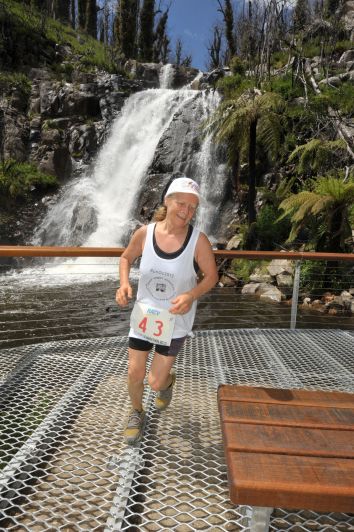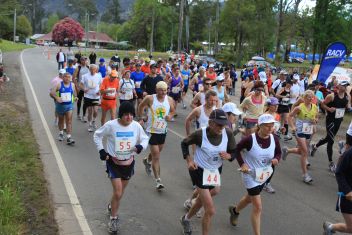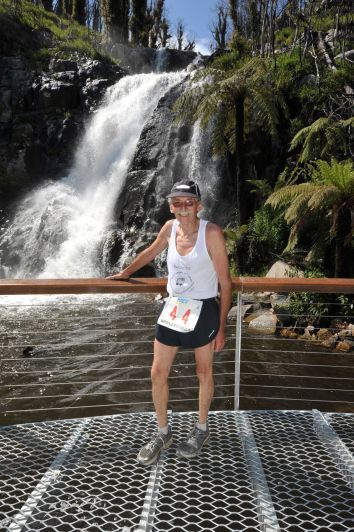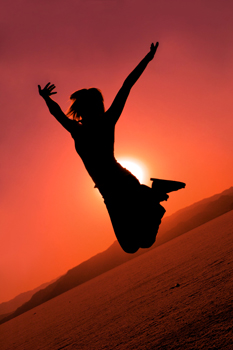Running RAW (‘Barefoot’) Around Australia
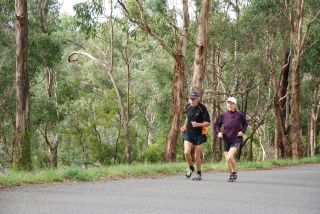
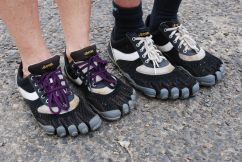
We run in Vibram 5-finger shoes to run as near to barefoot as possible. Running ‘barefoot’ around Australia was a conscious lifestyle choice – treading lightly on the earth.The benefits of running barefoot have long been supported by scientific research, coaches and athletes, who believe that a gradual system of training barefoot will strengthen muscles in the foot and lower legs, leading to a better running form through an increased sense of balance and greater agility. Running in Vibram Five Finger shoes enables us to experience the freedom and joy of running ‘barefoot’ while reducing the risk of exposure to obstacles that may cause injury. By running ‘barefoot’ around Australia in Vibram Five Finger shoes, we were more in tune with our bodies which deepened our connection with the earth.
Training for Running Raw Around Australia 2013
9 February 2012
Local 8km Fun Run, Warrandyte, Victoria, Australia. Alan finished 3rd overall out of 60 starters, at 66 was the oldest runner by 22 years! Alan ran the race in Vibrams Treksport 5-finger (toe) shoes.
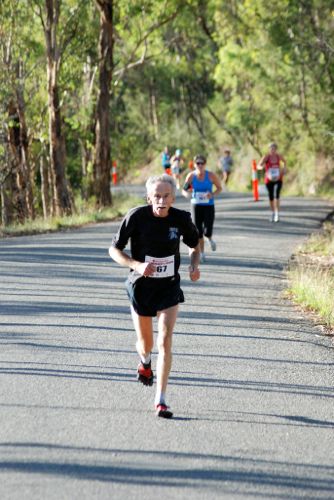
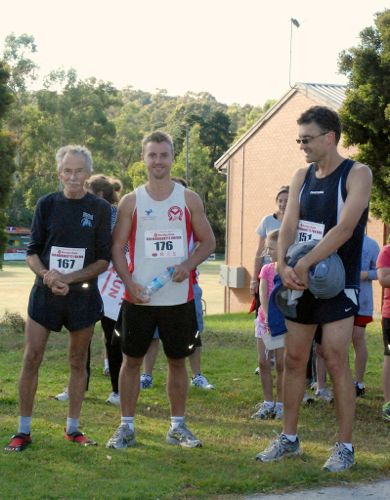
Alan running 8km Fun Run Alan finished 3rd overall
26 February 2012
Sri Chinmoy Melbourne (Australia) Race Series # 1 – 15km.Alan competed in the 5km and 15km race with12yr old barefoot running friend Emily. Alan was the oldest and Emily was the youngest in the Race. Alan ran the 5km with Emily then continued to finish the 15km. Alan ran in Vibrams Treksport 5-finger (toe) shoes, Emily ran completely barefoot!
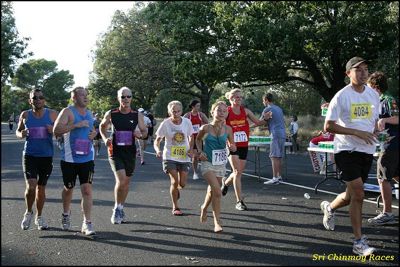
Alan (centre pic) running behind Emily (barefoot)
17 March 2012
Le Semi-Marathon de la Vente des Vins des Hospice, Nuits-Saint-Georges, France.It is a 10km and 21.2km race, the course is held on rocky, hilly trails through the vineyards, and cobbled streets through the villages of the Cotes d’Or Wine Region.Janette completed the 10km in 57min13sec, 21.2km in 2hrs 6min 49sec, placing 2nd in Veteran 3 Femmes Category. Janette ran the race in Vibrams Bikila 5-finger (toe) shoes except for the last 4km which was run completely barefoot!
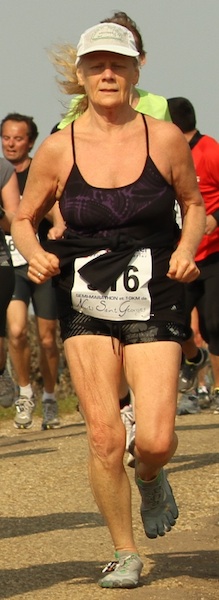
At 10km
Semi Marathon (21.2km) Cote d’Or, France. Photo credits – Pierre Bernard, France. Pre-Race Carbo Load:1 litre Green Smoothie (4 bananas, 4 dates, 1kg spinach, water), 6 bananas, 6 dates . During Race Fuel: 8 dates. After Race Re-Fuel:1 litre Green Smoothie (same as Pre-Race), 6 bananas, 6 dates.
25 March 2012
Sri Chinmoy Melbourne (Australia) Race Series #2 -18km Alan finished 1st in his category in1hr 31 min, at 66 he was the oldest participant in the race. Alan ran the race in Vibrams Treksport 5-finger (toe) shoes.
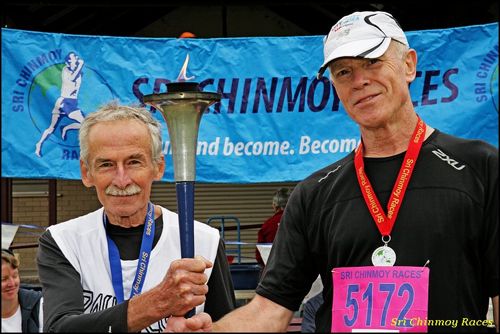
Alan 1st in Category (66yrs) Oldest in Race Sri Chinmoy 18km
22 July 2012
Sri Chinmoy Melbourne Race Series #3 – 30km was completed wearing Vibrams Treksport 5-finger shoes Alan finished 3rd and Janette finished 1st in their categories – 60-69 Veterans
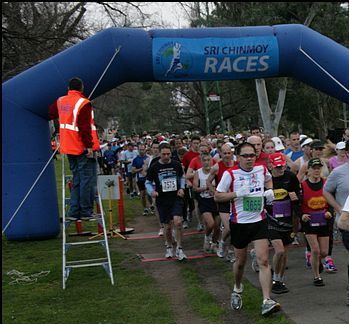
Previous Running & Race History
Endurance Events
NZ 2000km Run – Ran Length of New Zealand together – 2182km – 50 marathons each in 50 days
(Scroll down for article on NZ 2000 km Run)
Running RAW Around Australia – Ran Perimeter of Australia together – 15,782km – 366 consecutive marathons each
International Marathons
- Royal Victoria (Canada) Janette 5; Alan 3
- Country Roads (Canada) Janette 2; Alan 2
- Philadelphia (USA) Janette 1; Alan 1
- Big Sur (USA) Janette 1; Alan 1
- Burgundy Wine (France) Janette 1; Alan 1
- Alsace Wine (France) Janette 1; Alan 1
- Gorge (NZ) Janette 1; Alan 1
- Marysville (Australia) Janette 1; Alan 1
- Vancouver (Canada) Janette 1; Alan 2
- Log Train Trail (Canada) Janette 1; Alan 1
- Hawaii (USA) Janette 1; Alan 1
- Antwerp (Belgium) Janette 1; Alan 1
- Firenze (Italy) Janette 1
- Great Ocean Road (Australia) Janette 1; Alan 1
- Comox Valley (Canada) Janette 3; Alan 3
- Seattle (USA) Janette 1; Alan 1
- Paris (France) Janette 3; Alan 2
- Hamilton Millennium (NZ) Janette 1; Alan 1
- Buller (NZ) Janette 1; Alan 1
Marysville (Australia) Marathon Nov 2010
Ultra Marathons (x combined)
- Burning Boot 60km (Canada) Janette 1; Alan 1
- Woodstock Fruit Festival 50km (USA) Janette 1; Alan 1
- Australian Ultra Runners Assn 6 Hour (60km) Alan 1
- Kneeknacker 50kmTrail (Canada) Janette 3; Alan 2
- Great Ocean Road Marathon 45km (Australia) Janette 1; Alan 1
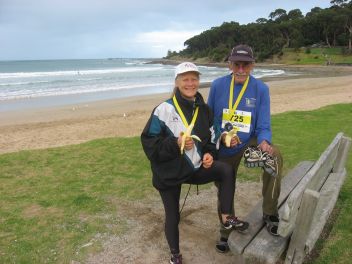
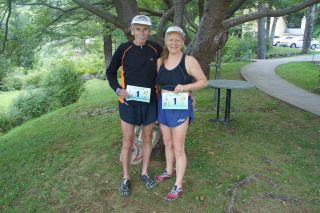
- Great Ocean Road Marathon & Ultra (Australia) May 2011
- Alan: Marathon 3:58:40; 45km 4:20:56
- Janette: Marathon 4:49:47; 45km 5:13:53
Both oldest runners finished 2nd in our category (Veterans 60-70 ).
- Woodstock Fruit Festival Marathon & Ultra (USA) August 2011
- Alan: 6hr 20min – Janette 6hr 35min
- Finished 1st in our categories (Veterans 60-70).
‘Millennium 2000km’
Running the length of New Zealand to Celebrate the Dawning of a New Millennium
Article by Janette Murray-Wakelin published in ‘Marathon & Beyond’ Vol 5 Issue 1/2001
When we sailed away from New Zealand in our 40-yacht 25 years ago with our two little children, we never anticipated that we’d eventually return to run the length of the island nation as a way of bidding farewell to the 20th century while welcoming the 21st. As parents in the early 1970s, we searched for an alternative lifestyle and an ideal environment in which our little family could grow. In that idealistic quest, we sailed into the unknown dream world of sea gypsies, water wanderers and wayward travelers through the swollen sea of life. A decade of cruising through a dozen countries while experiencing numerous cultural happenings created a family firmly bonded by a keen sense of adventure. It was this commitment to enjoying each other while living life to the fullest that hatched the idea in 1997 of meeting again in New Zealand to celebrate the dawning of the year 2000.
Over the years we had become avid runners, so it was natural that our new quest involve long distance running. We began to plan the challenge with the same detail we’d used over the years to set sail for new and exotic ports of call. My husband Alan (aged 54) and I (aged 50) would run the length of New Zealand some 50 marathons in 50 days, while our now adult children, Alana and Kaje would help with the planning, organizing and support. It was exhilarating to launch into yet another adventure as a family. Our years of traveling has taught us that good health, attainable through consistent physical exercise and sensible nutrition, was of great importance for any challenge we might set for ourselves. To run 50 marathons in as many days we figured the training would involve consistant long slow distance running, which would mean getting up early every morning and going for at least an hour’s run, concentrating on keeping the pace at approximately six minutes per kilometre. Over the three years of training we would build up the distance run every day to include a 42km run once a week while slowing the pace to roughly 7.3 minutes per kilometre.
It would be just as important to get the nutrition portion of the equation right. We have always believed that a balanced diet of natural foods and plenty of water is required to maintain a healthy body. Our training diet consists of fresh fruit and veggies, whole grains, brown rice and pasta, soy products, some fresh fish, pure grapefruit juice and water. We did not eat any junk food or fast food, no red meat or dairy products, no salt and no tea or coffee. We also did not use any forms of drugs, such as painkillers, anti-inflamatories and the like. Neither did we use sports drinks. We cannot possibly overemphasize the importance of high water intake in such an athletic venture toward remaining properly hydrated.We were able to secure several sponsors for what we were calling ‘NZ2000KmRun’, including Clifbar, a naturally balanced energy bar. We practiced eating a Clifbar with a banana and a fresh fruit smoothie before beginning each run and took a ClifShot energy gel at the end of each run. We made it a practice to always warm up with a 1km walk and to cool down with a 2km walk at the end as a way of preventing injuries from overtaxed cold muscles. Immediately following each run, we stretched for 20 to 30 minutes, using mostly yoga stretches and, when our feet were weary, we would first soak them in ice water to bring down any swelling, then in warm water with epsom salts afterward. A hearty brunch followed. We were also fortunate to be sponsored by McCoy fruit juice who provided us with 400 litres of pure grapefruit juice which we drank throughout the run. Other sponsors included Telecom NZ who provided mobile telephones essential for communications between us and our support crew. We also had sponsorship from Larry Dawe Cycles who provided a road bike and Asics Canada who provided 5 pair of shoes each, 3 pair of which we alternated during the run, all of which we wore out.
We realised that running a marathon a day for 50 days to cover the 2000-plus kilometres from Cape Reinga in the north to Bluff in the south of New Zealand would create a fair amount of interest throughout the country (and in fact worldwide, primarily through our website), so we decided to seize the opportunity to do some charitable fundraising. As we had two friends who had been disabled as a result of car accidents, we had a personal interest in a good cause. We approached Parafed Canterbury and ParalympicsNZ with the idea and suggested any funds raised should go toward helping athletes with disabilities achieve their sporting goals and, ultimately, to compete in the Paralympic Games 2000.
Upon our arrival in New Zealand from France early in November 1999, ParalympicsNZ took over organizing press releases to the news media and set up a website to encourage fundraising. We entered our daily diary notes throughout the run which were posted on the site. Our son Kaje (then 28) who had agreed to be our support crew throughout the run joined us from Scotland and our daughter Alana (then 30), married and at the time expecting our first grandchild), would monitor the e-mail address from San Fransisco and join us for the last two weeks of the run.The first thing we did was buy a suitable support vehicle, a solid diesel truck converted to a mobile home that slept 3 and was guaranteed reliable to go the distance. Kaje would be our driver, going ahead to stage water and food stops every 10km. He would also check out the next day’s run on the bike after we had finished for the day, which meant that he would bike twice the distance that we would run every day. He pushed us out the door at 5:30 every morning, watered and fed us, and was always there with words of encouragement. He was, indeed, our life support, and we couldn’t have done it without him.
On December 17th, 1999, we stood below the lighthouse at Cape Reinga at the north of New Zealand and briefly looked out towards the Pacific Ocean which, 25 years before, had carried us with the wind in our sails away on our first adventure together. Now we were embarking on another voyage of discovery, this time over land with the soil beneath our feet as we ran the length of our country-Aotearoa, as it is known to all New Zealanders. It was an emotional moment as the light flashed its last revolution as dawn broke, and we began to run.
The trail around the coastland past Cape Maria Van Dieman and down to 90 Mile Beach provided a rugged but beautiful start. Kaje drove onto the beach and was waiting with water, suntan lotion and camcorder. Two days of sun, sand and diminishing horizons running on 90 Mile Beach was an unforgetable experience. Never before had we run 42.2km in a straight line!
Once onto the roads, we settled into a daily routine of 5:30am starts, water and food breaks every 10km, applying suntan lotion on a regular basis and changing clothes and shoes as necessary, depending on the weather. For the first five days we had various shifts of pain and ‘niggles’. We would run along saying “right knee niggle”, “left ankle pain”, “right shoulder ache” and so on, comparing complaints as we progressed. The camber of the road played a big part in contributing to what we hoped would not become chronic injuries, as we had been training in Canada and Europe on the left side of the road and had to change to the right for oncoming traffic in New Zealand. We changed sides whenever it was safe to do so, on long straights and whenever there was a wide enough shoulder. We also tried to stay on the outside of country roads for better visibility by motorists.
After five days and five consecutive marathons, we were truly into ‘unknown territory’. We’d never been beyond that point in training. We continued on, gripped with a bit of apprehension, but found, apart from when we encountered adverse weather conditions, that we could hold our own. The weather played a huge role in how much energy we depleted during each run and the time it took to cover the distance each day. Our average daily running time was 5:15 hours, but actual time on the road, including stops, ranged from 5:45 to 8:15 hours. Basically, when we had especially heavy rain, strong headwinds or extreme temperatures, we merely changed gear (that is, ‘gear’ as in momentum and in clothes). When it rained we used vaseline liberally on our toes and areas subject to chafing, so despite several days of constant rain, which meant running in soggy socks for several hours, we did not suffer any blisters, chafing or foot problems (apart from developing toes that looked like pink prunes!) After ten days on the run we realised that as long as we stayed at a constant pace, we would not sustain any major injuries. However, we always knew that rough ground could cause a twisted ankle and that the danger of road running with traffic was ever present.The terrain ranged from flat straights (such as 90 Mile Beach and the Canterbury Plains) to steep hills (such as the Parapara Range and Dunedin’s Steepest Street in the World). We found that flat running caused more aches and pains than running hills because of the constant pounding and minimal range of motion of muscles. Generally, the rolling hills of New Zealand provided the best all-around terrain for running as well as the most interesting scenery.
We have never found running boring because there is always something to look at and something to think or talk about. After 30 years of marriage where we’ve always worked and played together, you’d think there wouldn’t be much left to say. But every day there was something new to discover: a different birdsong, native trees, animal antics in the fields, house design ideas and garden landscapes.
At the end of each day’s run, we set up camp in the truck. Most often we’d be close enough to a town where we could park in a campground overnight and return the following morning to the point where we’d stopped the previous day. Other days we would drive to family or friends who lived nearby. But often we would simply park where we ended our run: on the side of the road, under a tree or beside a river. Frequently, we were treated to local hospitality, including offers of hot baths, laundry service and even meals. After a rough day of cold rain and wind, a free night in a warm hotel or a heartwarming room in a country home was very welcome.
The greatest highlights of the run were undoubtedly when we were joined on the road by athletes with disabilities. Throughout New Zealand, ParalympicsNZ kept the Regional Parafed Groups informed of our schedule and in each area it was arranged for athletes and supporters to join us along the way. Having these wonderful people along put many things in perspective for us. The pain in our legs seemed to disappear when we were running alongside someone who was paralyzed or had no legs. We were honoured to run with new friends who had cerebral palsy, spina bifida, and disabilities ranging from visual impairment to tetraplegia. We enjoyed the company of paralympian medalists and youngsters aspiring to reach those heights. Their courage and determination inspired us to continue our commitment to finish the challenge we had set for ourselves.
Another highlight was running the Hamilton Millennium Marathon, held on January 1, 2000. The race constituted our 16th marathon in our sequence. We pushed a wheelchair with a donation box around the course and collected $800 from runners and spectators. More than 2500 participants came from over the world, including several athletes with disabilities. Of all of the marathons we have run worldwide, this was the most inspiring. We were later thrilled to learn that the marathon organisers had pledged $5000 toward our fund-raising.
Around the 37th day we went through a tough period, which we attributed to a growing lack of restorative sleep and quality rest periods. At the time we had a lot of media coverage, which involved interviews for newspapers, radio and television as well as fund-raising campaigns where we pushed the donations wheelchair around towns after finishing each day’s run. We now refer to this down period as “hitting the wall” because if we were to relate the 50 consecutive marathons to a single marathon, that would have been about the time and place you’d expect to encounter the dreaded Wall.
We managed to run through the exhaustion and nausea and come out feeling stronger and fitter than before. In fact, as we neared the end and began the countdown from 10 marathons down to the finish, we experienced feelings of invincibility, of wanting the run to continue and wishing we could turn around and run right back again. (Yes, Forrest Gump is our favourite running movie!) We did, in a rash moment, decide to enter and run the Buller Gorge Marathon, held a week after we were scheduled to finish the NZ2000kmRun. We figured we must be training toward something (Buller Gorge was a great marathon by the way, Alan did 3:39, I did 4:06 and we raised over $100)
Needless to say, our mortality was re-established during the last few days of slogging into Southland’s cold headwinds, in rain which at times we were sure would turn to snow. We were convinced that the endurance we had built up during the previous 40 marathons helped us run through those days and were thankful we had not encountered those conditions earlier in the run. Although most New Zealanders were disappointed with the summer weather, we considered ourselves fortunate that for most of the run we had near-perfect conditions, with cool, overcast days.
As we ran into Bluff on February 5, 2000, emotions also ran high, yet we felt sad the run was ending. We even slowed down to make the experience last a little longer. With the end of the road in sight, our son and daughter joined us and we all ran side by side, holding hands to the finish. It had been a team effort, a challenge we had set out to overcome together and a goal we had achieved as a family. We did it! We had run the length of New Zealand, 2182.2km-or 50 marathons in 50 days!
The awareness we raised and the funds we attracted through the NZ2000KmRun will go towards helping people with disabilities become rehabilitated and reintegrated into the community through the most effective medium of sports, recreation and leisure activities. The primary disability groups helped by Parafed Canterbury are paraplegics, tetraplegics, cerebral palsy victims, people with spina bifida, the visually impaired and amputees.
Postscript
In October 2000, Alan and I attended the Paralympic Games in Sydney, Australia as guests of the New Zealand Paralympic Team. It was a most inspiring experience and an honour to be in the presence of these incredible athletes who prove every day that if you ‘never stop pushing’ you can achieve whatever goal you set for yourself.
In the year 2013, to inspire and motivate conscious lifestyle choices, to promote kindness and compassion for all living beings, and to promote environmental awareness for a sustainable future, we ran together approximately 15,782 km around Australia, 366 marathons in 366 days.
Interesting Comparisons between NZ2000kmRun and RunRAW2013:
NZ2000kmRun RunRAW2013
Ages of Alan & Janette 54 & 50 68 & 64
# of Marathon distances 50 366
Total distance run 2182.2 km 15,782 km
Training Time 3 years 3 years
Type of shoes for run running shoes Vibram 5-finger shoes
# of shoes for run 3 pair each 16 pair each
Food Type Consumed Vegetarian/Vegan Raw Vegan
Energy Food on Run ‘Energy’ Bars dates & bananas
Type of Energy Drinks boxed juice fresh juice
Blister prevention vaseline Vibram5-finger shoes
Sun screen yes no sunscreen
Type of Fuel for Vehicles Petrol LPG Fuel
Type of Power Energy electric Solar

